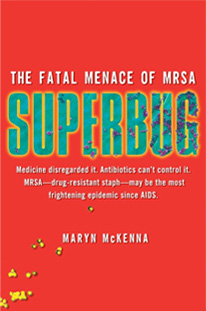
For nearly all her career, journalist and author Maryn McKenna has written about public health, from Midwest droughts to bird flu to Gulf War Syndrome. While covering the Centers for Disease Control and Prevention (CDC) for the Atlanta Journal-Constitution, McKenna got the nickname “Scary-Disease Girl,” a moniker that befits the infectious disease beat she has continued to pursue in two books, newspaper and magazine articles, and on her Wired blog, Superbug. TON co-founder Jeanne Erdmann recently spoke with McKenna to learn how she developed and keeps atop of the infectious disease beat, and how she juggles the various components of her writing life. (This interview has been edited for length and clarity.)
You had a story in the April 2011 issue of Scientific American called The Enemy Within [subscription required], about a new type of antibiotic resistance. How did that story come about?
This is a story about a form of antibiotic resistance that has been moving across the globe for a decade, but with very few people noticing it or becoming alarmed about it. It’s high-level resistance to last-resort drugs called carbapenems in some Gram-negative bacteria, which are common and difficult-to-treat causes of hospital infections. It wasn’t much noticed because it was overshadowed by public interest in MRSA, drug-resistant staph, which is Gram-positive. Those categorizations, Gram-negative versus Gram-positive, are significant because it is much more difficult to formulate antibiotics that work against Gram-negatives.
I had just written a book about MRSA, and in the years I was immersed in it, I kept hearing physicians say, “Well, we know MRSA is a problem, but what we’re really worried about is the Gram-negatives.” I heard that enough to realize I needed to look into it, and when I did, I started to understand that it was a sweeping, complex story that needed to be told.
How did you pitch the story to Scientific American?
Christine Gorman [health editor at Scientific American] and I had been acquainted for years because we wrote about many of the same topics but in different venues: I was a newspaper person and she was a magazine person. We knew each other’s bylines and then we talked a few times after she left Time and went freelance. Then I left newspapers and became a freelancer also. When she went to SciAm she let me know and asked for pitches. I sent two or three ideas to her—quick notes, a paragraph each—and she came back and said, “This is the one that most resonates.” And then we went through the formal pitch process of a memo and subsequently an outline. [editors’ note: see pitch in supplementary material]
If there’s a lesson in that, it’s: Never lose track of people. That has been reinforced for me in the five years I’ve been a magazine writer. There are editors I know who have been in three jobs in those five years. Maybe someone won’t take something from you at Magazine X, but don’t lose their email—a year from now they may be at Magazine Y.
What kicked the Gram-negative bacteria up your list as something to write about?
Last fall there was a lot of alarm about NDM-1, the “Indian Superbug” (which is not actually a bug, but an enzyme that is produced by several bacteria). It caught my eye because NDM-1 appears in Gram-negative bacteria, and resistance in Gram-negatives was something I was already hearing about.
The NDM-1 news provided a peg for the larger story of resistant Gram-negatives. But it also in a way held up a mirror to it, because there’s a default position in stories about emerging infections, which is that the new disease comes from the developing world to menace the industrialized world. I began to see that what made the carbapenem-resistance story so interesting was not just that it was unknown, or that it was expanding into an international epidemic, but that it reversed the standard narrative: Carbapenem resistance didn’t come from the Third World; the first sighting was in North Carolina. That was what made the story fresh for Scientific American.
You mentioned in an earlier conversation that when you’re researching a story, you read a paper and then read every single paper that paper references.
Is that crazy? I look up every footnote; I read whatever papers in them look interesting, and then I look up the footnotes in them too. It builds a stepwise journey back through the story that is almost always very satisfying.
Can you give me an example?
The MRSA epidemic started in 1961, with the recognition of three cases in an English hospital just 11 months after introduction of the drug methicillin, the M in MRSA. I was researching why methicillin came to be created, because that drug is no longer used today. The answer turned out to be that when penicillin was introduced in the mid-1940s, society went mad for it and vastly overused it, leading to a worldwide epidemic of penicillin-resistant staph for which there were no remedies.
I was going through the records of a summit meeting that the American Medical Association convened about this pandemic in 1953—it’s fascinating reading because the sense of hopeless panic is so strong—and deep in the account was a reference to a research project that had treated this virulent resistant staph without using drugs. I had never heard of this, so I started pursuing the thread backward, and it turned out to be an astonishing story.
This penicillin-resistant staph was very bad. People would bleach or burn everything they owned, to get rid of it; they moved house; they got divorced. It destroyed families. In the midst of this, two physicians at a hospital in New York City got the idea to try something that had been accidentally discovered in diphtheria treatment 50 years before, which was that the ecological niche of one bacterium could be filled by another, and so prevent the disease that the first one would have caused. They searched around for someone who seemed to be immune to this very resistant staph. They found one nurse, harvested another strain of staph from her—one that seemed to colonize the body well but didn’t cause disease—and then deliberately infected newborns with this other strain. It was bold, and these days probably wouldn’t be allowed, but it worked: They shut down their hospital’s outbreak.
However, they succeeded just as methicillin, the next great cure for staph, was introduced, and so their success was forgotten. I tracked back to their original papers and then traced the physicians—they were both still alive, in California and Texas—and they were thrilled to tell the story because they felt it was lost to history. That’s Superbug’s Chapter 2.
How did your first book, Beating Back the Devil, evolve?
In 1996, I went to the Atlanta Journal-Constitution. Atlanta is the home base of the CDC, but the paper had been ignoring the agency for a long time. Then the Olympics came to Atlanta and the planning for possible importation of disease reminded the paper that the CDC was in its own backyard. So they gave me the mission of just getting inside and telling its stories.
For a disease geek, it was like being handed the keys to a private candy store. I had the incredible good fortune to be assigned to the CDC when nobody else was paying sustained attention to it—15 years after the first recognition of AIDS and five years before 9/11 and the anthrax attacks. There were no guards, no magnetometers; I had a parking space and I could walk in, sign in and go straight to somebody’s lab. I got an incredible amount of face time with the researchers there and had a lot of opportunities to talk my way into their field investigations.
That made a big difference when the anthrax attacks came in October 2001. The CDC became much less accessible, changed its procedures for press forever—but at that point, I already had relationships built up, and I was able to talk my way into one of the investigative teams on Capitol Hill.
During that embed I noticed how many of the CDC workers were young doctors and Ph.D.s—younger than me—and I eventually figured out that they were members of the CDC’s disease detectives, the Epidemic Intelligence Service, who join right out of residency or instead of a post-doc. After anthrax was over I proposed following them around for a year to see what their lives were like. I did it first as an episodic newspaper series, but an editor lost interest in the project about halfway through. So I wrote it up as a book proposal, and that became Beating Back the Devil.
How did you establish your niche as a freelancer when you left the Journal-Constitution?
First, I tried to figure out what I had that would make me distinctive to magazine editors, compared to all the other reporters coming out of collapsing newspapers. Someone who sat close to me at the AJC had called me “Scary-Disease Girl” one day. So I thought, “Right, that’s my established specialty; I’ll market myself on that.” The second thing I did was try to broaden my specialties and find new topics to write about. I had covered some disasters and was interested in emergency medicine, so I applied for a fellowship at the Kaiser Family Foundation, to study emergency room overcrowding and stress.
How did you get the idea for your second book, Superbug?
When I got the Kaiser fellowship, I made it into an embed: I did 8 overnight shifts a month for a year. I thought I was going to do a book on ERs, but while I was doing those observations, I kept seeing a lot of MRSA. I met Sara Austin, the news and health features director at Self, at a conference, asked if I could send her some ideas, and sent five or six, including one on how MRSA was an under-appreciated threat to women. She accepted that one. The story was published in February 2007, and was immediately picked up by the Today Show and the Montel Williams Show, which suggested the topic had broad demographic appeal. On the basis of that I wrote a book proposal with my agent, Susan Raihofer, in about two weeks. And she sold it about two weeks later, and that’s the genesis of Superbug.
(The ER strategy did eventually work also, in that it led me into an ongoing contributor relationship with the Annals of Emergency Medicine, where I do several stories per year.)
How long did you work on the book?
About two and a half solid years. I asked for two years and in the midst asked for six extra months. I regret now that I did that. It made the book better, but it also put it into a different publishing cycle. There were a lot of science and medical books out in the beginning of 2010. So, a lesson: When an editor suggests a publication date for your book, she probably has a reason.
Changing gears to talk about how you manage your beat more generally, how do you organize your material?
I’m a Mac user. I put everything—transcripts, journal articles, PowerPoints, screenshots of web links—in DEVONthink [screenshot] because it creates a searchable database; that program will also show you associations that you might not have noticed between pieces of material. I make a master index with OmniOutliner [screenshot], and also use that for outlining when I’m getting ready to write. For anything that requires a chronology I use FileMaker Pro [screenshot]; you can set that up so that, for any single entry, you’re filling out something that looks like an index card, but it exports into something that looks like an Excel spreadsheet. It’s very useful for building chronologies. For instance: When I was reporting Superbug, I set up a Google Alert for any MRSA outbreak, and entered each one into Filemaker. That returned a spreadsheet of community MRSA outbreaks over three years or so, which both gave me a rough anecdotal sense of what was going on in the U.S. and also yielded places and contacts that the book’s publicists could use in marketing efforts. This system worked pretty well, but isn’t perfect because the programs don’t talk to each other. I’m sure there’s a better way to do it, it’s just what I happened to work out at the time.
What journals do you follow regularly?
I read Morbidity and Mortality Weekly Report, the CDC’s weekly bulletin, and Emerging Infectious Diseases, its monthly journal; Clinical Infectious Diseases, Journal of Infectious Diseases, Infection Control and Hospital Epidemiology. Pediatrics, JAMA, NEJM, Nature, Science, BMJ, Lancet, Lancet Infectious Diseases, PLoS Medicine, PLoS One, BMC Infectious Diseases, and the listserv ProMED Mail. I read the push from Eurekalert every morning for all the embargoed journals.
I rely on my Twitter stream to alert me to other things. This week I’m reading a paper from Nature Mucosal Immunology that I would never have found on my own. I also use Google Alerts and the “My NCBI” push at PubMed. I did that when I was writing Superbug and every week got 40 new papers on MRSA.
How do you budget your time?
I am not ashamed to say that I’m really struggling with this, as a magazine writer who is also doing a lot of social media who is also doing a well-read blog. I am worried all the time that I’m prioritizing the short-term deadline for which I make little money but get lots of attention over the long-term assignment from which I’ll pay my bills. The practical effect is that I work crazy hours. I worry my health is suffering; I spend too much time on my butt in a chair.
When did you start blogging?
I started at Blogger.com within a month of signing my book contract, around March 2007. I had stopped working for the newspaper, I had had just one big magazine story; I was worried about people not remembering my byline, and now it was going to be a couple of years to the finished book. I thought the blog would associate my byline with this topic, so that I could claim my turf. I also wanted to start building an audience for the book, and also crowdsource my research—that is, build a reading community that would tell me about papers that I’d missed or cases they had treated or difficulties in infection control. And that turned out to be true. After Superbug was published and got some attention, I went from Blogger to ScienceBlogs, and then back to Blogger after the Pepsi-ethics implosion. The Wired network started almost a year ago. I’m really happy to be there.
Your self-designed beat involves covering a lot of gruesome traumas. Can you talk about how being a fellow at the Dart Center for Journalism and Trauma, at Columbia University, has helped you deal with that?
The Dart Center is a fantastic group of people who do several different things. They serve as an expert resource for people writing about traumatic events like violence, plague, and disaster; they maintain a clearinghouse for good stories; and they help people who do this kind of journalism find each other and offer support.
It’s traumatic to write about trauma. Journalism was one of the last professions to own up to that; cops and firemen for years had critical incident stress debriefings, while journalism clung to this myth that we are tough, nothing affects us. Which is crap. If you don’t allow yourself to be affected, you won’t deliver good journalism. Remaining open to people’s suffering is our job.
I spent weeks in Thailand after the tsunami, at one point in a temple where they were working to identify 3,000 decaying bodies, and that same year I went to Katrina. I am quite sure I had PTSD for a while after that, and when I started to report Superbug, which has a lot of dying children in it, a lot of those issues rose up for me again. Dart gave me people to share that with. They also coached me in how to write and talk about people who are undergoing traumatic events without re-victimizing them. If I had to sum it up, they taught me not to be a vulture.
A glimpse behind the scenes:
- Pitch (Scientific American)
- Organizational software screenshots

Jeanne Erdmann is co-founder and editor-at-large of The Open Notebook. Follow her on Twitter @jeanne_erdmann.



